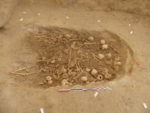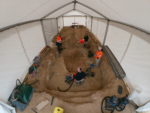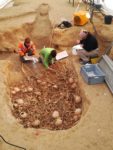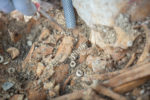 Archaeologists have discovered a Neolithic hypogeum, an underground tomb with a corridor leading to the burial chamber, in Saint-Memmie, a town in the Marne department of northeastern France. It dates to 3500-3000 B.C. and contains the skeletal remains of at least 50 individuals, plus grave goods including limestone beads from a necklace, perforated animal canines used as pendants and flint tools.
Archaeologists have discovered a Neolithic hypogeum, an underground tomb with a corridor leading to the burial chamber, in Saint-Memmie, a town in the Marne department of northeastern France. It dates to 3500-3000 B.C. and contains the skeletal remains of at least 50 individuals, plus grave goods including limestone beads from a necklace, perforated animal canines used as pendants and flint tools.
 The Marne region has a particular concentration of hypogea due to its chalk subsoil which makes digging under the ground or in the sides of cliffs comparatively easy. While 160 of them have been found in Marne over the centuries, only five of them have been scientifically documented. The rest were dug up and emptied out without archaeological investigation. The Saint-Memmie excavation, therefore, is a unique opportunity to use the latest and greatest methods and technology to reveal new information about this funerary practice.
The Marne region has a particular concentration of hypogea due to its chalk subsoil which makes digging under the ground or in the sides of cliffs comparatively easy. While 160 of them have been found in Marne over the centuries, only five of them have been scientifically documented. The rest were dug up and emptied out without archaeological investigation. The Saint-Memmie excavation, therefore, is a unique opportunity to use the latest and greatest methods and technology to reveal new information about this funerary practice.
 The hypogeum consists of an entrance opening on to a sloping corridor 12.5 feet long. It widens out to an antechamber that tightens again, leaving just wide enough a doorway for a man to pass through. This design is typical of the hypogea in the Marne region, but it does have one unusual feature: the entrance was accessible from ground level when it was built.
The hypogeum consists of an entrance opening on to a sloping corridor 12.5 feet long. It widens out to an antechamber that tightens again, leaving just wide enough a doorway for a man to pass through. This design is typical of the hypogea in the Marne region, but it does have one unusual feature: the entrance was accessible from ground level when it was built.
 The chamber is 65 square feet in area and contains multiple layers of bones. They are densely packed in the space, interlocked with each other, and some of them have been burned. There are remains of adult men and women, adolescents, young children and infants. More than 2,000 bones and 50 skulls have been unearthed thus far.
The chamber is 65 square feet in area and contains multiple layers of bones. They are densely packed in the space, interlocked with each other, and some of them have been burned. There are remains of adult men and women, adolescents, young children and infants. More than 2,000 bones and 50 skulls have been unearthed thus far.
The excavation will continue for a month and the bones will be painstakingly recorded before removal to allow archaeologists to unravel  the threads of how the bodies were deposited and when, how the bones were rearranged both by natural means when the tissues decomposed and artificially when the remains were reorganized during later deposits. Laboratory analysis of the bones will hopefully give a more precise idea of the number of people buried here, their age at time of death, sex, health, any familial relationships and the date range of when the hypogeum was in use.
the threads of how the bodies were deposited and when, how the bones were rearranged both by natural means when the tissues decomposed and artificially when the remains were reorganized during later deposits. Laboratory analysis of the bones will hopefully give a more precise idea of the number of people buried here, their age at time of death, sex, health, any familial relationships and the date range of when the hypogeum was in use.